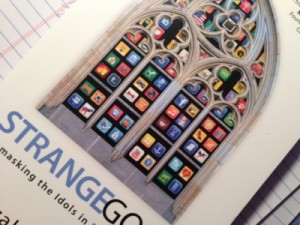In the last post, we talked about ‘senses’, the gut feelings, unquestioned assumptions, and ‘unknown unknowns’ that frame our thoughts and beliefs, often deciding what we choose to accept and reject.
We concluded by posing some questions:
How do people form and change their narratives, their “senses”, their social imaginaries? Can it even be done? How can we know our unknown unknowns, anyway? And aren’t Catholics as sense-bound as the next guy?
Not being Damon Lindelof, I try to make a habit of answering the questions I raise – so away we go!

This post from Rod Dreher suggests one way that people can change their ‘sense’ of things: an overwhelming encounter with beauty. He’s written many times about how a visit to Chartres Cathedral as a young man opened his mind to a very different way of thinking:
(It was) as pure an experience of aesthetic beauty battering down a door in one’s mind as I can imagine. I didn’t leave Chartres as a Catholic, but
I did leave Chartres a different man, one who was now open tothinking about God and Christianity and myself in a different way. Catholicism was foreign to me, but after Chartres, it was less so, because the particular beauty of that cathedral, built by French Catholics in service of God as revealed to them by Roman Catholicism, resonated with something very deep inside of me, and began the process of revelation. I wanted to know more.
This last sentence is key – it’s not that beauty somehow converts people to Catholicism overnight: rather, it can open minds to the possibility of something more, expanding the bounds of possibility beyond what a materialist “sense” would allow.
This kind of beauty can be found in stories, too: think of all the Christians inspired by the worlds created by Lewis and Tolkien. In the course of a long and quite excellent comment on my last post, Dagnabbit_42 wrote that this was the key to evangelising people’s “senses”.
I think the answer/solution is “better art, and more of it”; where “art” means all the creative works which dominate popular culture for every relevant market: children, teenagers, men, women, the poor, the middle class, and the intellectual elite; and where “better” includes a very stiff dose of “more beautiful” and “more moving.”
…
Phillip Pullman’s awareness that C.S.Lewis and J.R.R. Tolkien’s works tended to “baptize the imagination” was basic common sense in this area; since he wanted imaginations unbaptized, and paganized he naturally wrote works which were philosophically gnostic, making them as appealing and beautiful as he could to draw in more readers, whose habits of mind would then be drawn away from Christianity and into a philosophical “sense” incompatible with Christianity.
This sense-shaping through storytelling just works: it’s happening all around us. Jonathan Chait’s New York Magazine piece on Hollywood’s liberal bias and the way in which it’s affected Western (and especially American) society over time is one of the most interesting pieces of journalism of the last few years – all the more so because Chait is a man of the Left.
Besides beauty, there’s another major way in which people can change their ‘sense’: through an encounter with a person or group of people who has quite different assumptions to your own.
The psychologist Jonathan Haidt has written perhaps the best books out there about how ‘senses’ actually work. His book The Happiness Hypothesis examined how we think and make decisions, and the follow-up The Righteous Mind analysed the ways in which conservatives and liberals think differently, and the set of values each tends to give priority to, their ‘moral matrices’.
The inimitable Alan Jacobs recently blogged about The Righteous Mind, wondering, again, how these moral matrices form and change:
(T)here’s a question that Haidt doesn’t directly answer: How do we acquire these initial moral intuitions? — Or maybe not the initial ones, but the ones that prove decisive for our moral lives? I make that distinction because, as we all know, people often end up dissenting, sometimes in the strongest possible terms, from the moral frameworks within which they were raised.
So the question is: What triggers the formation of a “moral matrix” that becomes for a given person the narrative according to which everything and everyone else is judged?
Jacobs draws on a concept named by CS Lewis in order to hazard a guess at how this happens – the “Inner Ring”.

[Lewis] called his audience’s attention to the presence, in schools and businesses and governments and armies and indeed in every other human institution, of a “second or unwritten system” that stands next to the formal organization.
You discover gradually, in almost indefinable ways, that it exists and that you are outside it, and then later, perhaps, that you are inside it…. It is not easy, even at a given moment, to say who is inside and who it outside…. People think they are in it after they have in fact been pushed out of it, or before they have been allowed in; this provides great amusement for those who are really inside.
Lewis does not think that any of his audience will be surprised to hear of this phenomenon of the Inner Ring; but he thinks that some may be surprised when he goes on to argue, in a point so important that I’m going to put it in bold type, “I believe that in all men’s lives at certain periods, and in many men’s lives at all periods between infancy and extreme old age, one of the most dominant elements is the desire to be inside the local Ring and the terror of being left outside.”And it is important for young people to know of the force of this desire because “of all passions the passion for the Inner Ring is most skillful in making a man who is not yet a very bad man do very bad things.”
…
This, I think, is how our “moral matrices,” as Haidt calls them, are formed: we respond to the irresistible draw of belonging to a group of people whom we happen to encounter and happen to find immensely attractive.
**
It’s well worth reading the whole thing. Jacobs warns about the corrupting potential of the Inner Ring, but concludes on a hopeful note, saying that the Inner Ring’s power (unlike that of its Middle-Earth counterpart) can be used for good too. Is this not, after all, how holiness works? If there is anything to our faith at all, there should be something attractive, something compelling, about a person or group of people living it well.
So Catholics should be in the business of living out a culture of encounter, meeting people where they are, and trying to live as though there’s something to this nonsense. Again, this shouldn’t be a replacement for arguments or logic, some kind of attempt to win converts by force of personality or the promise of a good time – it should be about opening hearts and lowering barriers. Even Leah Libresco, perhaps the most rigorous rationalist I’ve ever had the pleasure to meet, had to first have her preconceptions about religion and the religious overturned by encounters in college in order to properly hear the case for God.
Pope Benedict demonstrated his bona fides as a shrewd observer of human nature when he wrote (as Joseph Ratzinger) that “The only really effective apologia for Christianity comes down to two arguments, namely, the saints the Church has produced and the art which has grown in her womb.”
But let me sound a note of caution. All this brings with it a very important proviso: Christians are not exempt from human nature. We are just as powerfully shaped and bound by our ‘senses’ of things as anyone else.
How, then, do we really know what kind of Inner Ring we’re in – whether we’re truly drawing people towards the truth, or away from it?
Alan Jacobs:
The element of sheer contingency here is, or ought to be, terrifying: had we encountered a group of equally attractive and interesting people who held very different views, then we too would hold very different views.
And, once we’re part of the Inner Ring, we maintain our status in part by coming up with those post hoc rationalizations that confirm our group identity and, equally important, confirm the nastiness of those who are Outside, who are Not Us. And it’s worth noting, as Avery Pennarun has recently noted, that one of the things that makes smart people smart is their skill at such rationalization: “Smart people have a problem, especially (although not only) when you put them in large groups. That problem is an ability to convincingly rationalize nearly anything.”
Nor is beauty an infallible guide. Dreher:
Beauty is not the same thing as truth. Beauty can mislead. The classic example of this is Leni Riefenstahl’s “Triumph Of The Will,” the Nazi propaganda film, which is absolutely gorgeous and heart-stirring. And evil. Truth is not always beautiful.
But when you have truth united to beauty, you have something very powerful indeed. Beauty is unsettling because our response to it is visceral, not intellectualized. We are not pure minds, but our minds are incarnate, inseparable from our bodies. Beauty seduces. The question of whether or not it seduces one towards truth and light, or towards falsehood and darkness, is a separate one, but not nearly as separate as we might think.
How can we know whether or not we’re on the side of truth, and of goodness?
Well, we can’t, not for sure – there is no such thing as the view from nowhere, and it’s impossible to escape having a ‘take’ on things, a lens through which we view the universe.
But we can keep checking that lens, keeping it clear and polished – and being willing to change our prescription.
How? The answer, I think, lies again in the encounter with others. If we refuse to ghettoize ourselves, if we embrace what Pascal-Emmanuel Gobry calls “the Francis option”, if we strive for a Church “bruised, hurting and dirty because it has been out on the streets”, we’ll have countless chances to encounter, listen to, and grow in love for people with very different ‘senses’ from ours – and so to see the world through their eyes.
And it’s essential that we do this while cultivating a hunger for truth, and a willingness to change our minds.
This may seem like counter-intuitive advice for a Church in which authority is so central. But Catholicism’s core claims (including its claim to legitimate authority) are ultimately either true or they aren’t. And if they are, their truth will only be illuminated by exposure to different points of view. We should be merciless with our ‘sense’ of the world, throwing at it every question and objection we can, delving into every apparent hole, hammering away at every contradiction; exposing ourselves to beautiful art and powerful stories that challenges us, befriending the most impressive atheists or Muslims or Buddhists that we know, checking and checking if our map of reality is accurate, striving to bring our “unknown unknowns” into the light.
It was St. Paul who told us to “test everything, and hold fast to what is good”. A faith that has gone through such a process will be all the stronger.
Update: I was just about to post this when I came across a really thoughtful response to my last post from Tod Warner over at A Catholic Thinker. He focused on an important compoenent of our “sense” of things, the sources that we trust to speak truth – and how sometimes we can end up ignoring wise words because they come from a source we don’t trust.
I am saying that sometimes a truth or piece of wisdom can come out of an unlikely or even unattractive source whether we like it or not. There is no doubt it is sage wisdom to “consider the source”. Indeed. But in order to avoid being blinded by our own bias, sometimes – perhaps only sometimes – it is good to stop and NOT consider the source.
This kind of interchange, with bloggers building on and fleshing out each others’ ideas, is one of the things I’ve enjoyed most as a Patheos reader – so to be part of it is more than a little thrilling. Muchos Gracias to Tod!












